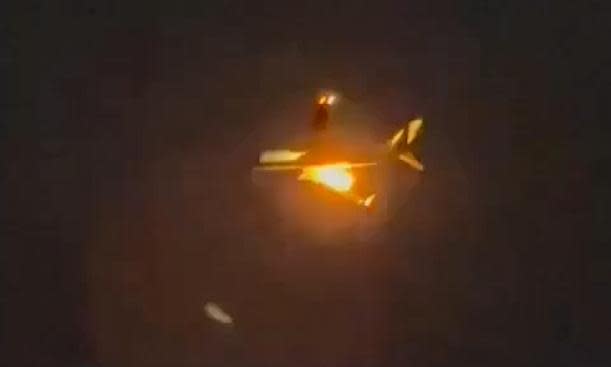Likely ‘a bird strike’: Virgin Australia flight makes emergency landing in New Zealand after engine fire

A suspected bird strike has caused a Virgin Australia plane to make an emergency landing in New Zealand after one of its engines caught fire shortly after takeoff.
The Melbourne-bound flight left Queenstown on Monday evening with footage emerging later that appeared to show fire coming from the Boeing 737-800.
Flight tracking websites show that immediately after taking off the plane headed south from Queenstown – rather than west to Melbourne as was scheduled.
Related: FAA investigates after Southwest plane drops to ‘within 400ft’ of Pacific Ocean
It performed a holding pattern while flying over the South Island before landing at the airport in Invercargill, about 150km south of Queenstown.
The Boeing 737-800 jet was carrying 67 passengers and six crew. It landed safely about 50 minutes after leaving Queenstown and was met by fire trucks on the tarmac.
“At this time, we are not aware of any physical injuries to guests or crew,” Virgin Australia’s chief operations officer, Stuart Aggs, said.
Passengers said they saw flames coming from one of the engines and heard loud bangs, the New Zealand Herald reported.
Michael Hayward said it was completely dark outside when the plane took off at 6pm local time.
“Within 10 seconds of going airborne, you hear just the loudest ‘bang’, golden lights filling within the cabin and a burst of flames off the right-hand engine,” he told ABC radio.
Hayward said he was quite anxious as were the other passengers – with a few cries in the cabin as people realised something had gone wrong.
“I could see flames shooting out of [the engine] at regular intervals,” he said, adding the captain later informed passengers the plane had hit a flock of birds.
“There was an initial worry but it wasn’t long until people realised OK, it’s under control, so just sit back, relax and whatever happens happens.”
Queenstown airport’s chief executive, Glen Sowry, said on Tuesday that a bird caught in the engine was the most likely cause of the incident.
“At this stage, we believe that it’s highly probable that it was a bird strike, but until such time as the engine has been inspected by engineers in Invercargill we won’t be able to confirm that for sure,” Sowry told RNZ.
Bird strikes were a known risk but incidents were infrequent, the CEO said. The airport took regular risk-management measures, including keeping the grass short and not allowing standing water nearby.
“If you get a bigger bird that is ingested into an engine, which looks probably what may have occurred on this occasion, then – depending on where in the engine it goes – it can damage critical parts.”
The runway had been inspected two minutes before the plane took off and no bird activity had been recorded, Sowry said.
Aircraft are designed to be able to operate and land using one engine.
The Virgin Australia flight most likely took a pre-determined safe route, designed for instances of engine failure, to avoid nearby mountains, Sowry said on Tuesday.
Queenstown airport released a statement confirming the flight “experienced an issue just after takeoff” and was diverted to Invercargill.
Passengers were given accommodation in Invercargill overnight and were then transported back to Queenstown airport where they were expected to be booked on alternative flights to Australia on Tuesday.
The rate of birds striking planes at New Zealand’s airports is about four in every 10,000 aircraft movements, the country’s aviation regulator says on its website.
– Additional reporting Australian Associated Press

 Yahoo Finance
Yahoo Finance 